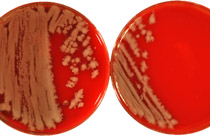Baylis SA, Finsterbusch T, Bannert N, Blümel J, Mankertz A (2011): Analysis of porcine circovirus type 1 detected in Rotarix vaccine
Vaccine 29 (4): 690-697. Epub 2010 Nov 18. doi:10.1016/j.vaccine.2010.11.028.
A metagenomic analysis of live human vaccines has recently demonstrated the presence of porcine circovirus type 1 (PCV1) DNA in the paediatric vaccine Rotarix used in the prevention of acute gastroenteritis. Using real-time PCR for PCV1, titres of PCV1 DNA in several batches of Rotarix were found to be in the order of 6–7 log10 copies per dose. Pre-treatment of the reconstituted vaccine with the nuclease Benzonase, followed by extraction of nucleic acid and quantification of PCV1 DNA by real-time PCR, revealed that there was no loss of PCV1 DNA titre compared to untreated controls, suggesting that the porcine viral DNA was present in the vaccine in an encapsidated form. PCV1 permissive PS cells, human HEK293 and Vero cells, used for vaccine production, were infected with Rotarix or PCV1, respectively, and subjected to immune fluorescence and RT-PCR. Viral genomes were present in Rotarix-incubated as well as PCV1-infected cells, while viral transcription was seen only in PCV1-infected cells. Similarly, PCV1-specific protein expression was observed in PCV1-infected cells, but not in cells treated with Rotarix. Passaging of the supernatant indicated productive infection in PCV1-infected PS cells, but not in HEK293 and Vero cells or in any cell line incubated with Rotarix. PCV1 DNA present in Rotarix was protected from Benzonase digestion; however, PCV1 was not recognized in immune electron microscopy and unable to infect PS, HEK293 or Vero cells, suggesting that the high amount of PCV1 DNA present in Rotarix does not reflect a corresponding proportion of biologically active virus particles.






